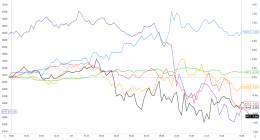
Opinions expressed by Entrepreneur contributors are their own.
The best way to pass safely through a storm is often by being prepared before it hits. In the case of ecommerce startups, that means bracing for rising advertising costs, inventory delays and expensive capital. Jamie Dimon, the CEO of JPMorgan & Co, suggests building a “fortress balance sheet,” one capable of withstanding these economic and industry shocks, is an absolute must for surviving the storm.
However, the wiser would argue building a fortress “offer model,” one able to withstand fluctuating ad costs, purchase behavior and cash flow is another one of those necessities ecommerce owners, founders and marketers need to include as part of their strategy.
Related: 3 Ecommerce Trends You Need to Know in 2023
The basics
An offer model is a framework that outlines your product or service’s value proposition (i.e., benefits you’re delivering on), features (i.e., what’s special about your product), pricing (i.e., the cost and discount) and guarantee (i.e., returns and warranties). This is how brands communicate their messaging on their website and ad creative to capture the interest of their target audience.
An offer model should capture the customers’ attention with a unique value proposition, educate the customer about the product and its differentiators, drive urgency with an incentive to purchase and alleviate any last-minute concerns with a money-back guarantee.
Why YOU
What to include in your offer model will depend on your customers. That requires some research. Dig through your customer reviews, your competitors and your competitor’s customer reviews. You’d be surprised that many customers will just tell you why they decided to purchase the product and the parts of the offer model they liked most.
Having an offer model that’s “unique” is something you need to prove, show and/or quantify. If you’re not offering a unique solution to a problem, then the question of “who else?” is inevitably going to pop into the customers’ minds. With the power of Google, I can have all your competitors pulled in a matter of seconds.
Competitor comparison charts can be an effective way of showcasing your unique value propositions and can limit “shopping around” behaviors. Ask yourself:
-
What does my product do better than any other competing solution on the market?
-
Why would a customer purchase from me instead of each of my competitors?
-
What are the benefits, features and/or ingredients that my competitors are missing?
Create value and show it
There’s a difference between how you value your products or services and how your customers perceive that value. A $50 product to a business owner is only the value of the cost of making the product and delivering it to your door. For the customer, it’s the value of using the product to solve a problem or achieve a desired outcome. This difference in value is something that can be leveraged to your advantage in creating more value for your customers.
For example, offering a “free gift” to a customer that purchases from you — say they bought a bottle of shampoo and you’re giving them a free sample pack of your conditioner. It may cost you ~$2-$3 to make and deliver this free gift to the customer. However, the customer’s perceived value of this gift will often far exceed this, being more in line with the market value of the gift they’re receiving. Instead of offering the customer a 20% discount, which reduces your order value, consider offering them a free gift to take advantage of this value difference.
You can also use free gift cards to maintain the same effect. Offering a $25 gift card with your first purchase is a $25 value to the customer — even though you know the money will have to be spent on your store to purchase your products. The customer will either use the card themselves or give it to a friend — either way, you got yourself a new sale.
Showcasing the value of any free shipping, free warranties or free delivery insurance is another way of showing value. You’re paying for these, but the customer isn’t. Informing the customer of the ~$15 shipping they’re getting for free can help the customer better justify the purchase price.
Related: 4 Ways to Make Value Creation Core to Your Business
Combating high ad costs
There are also ways to leverage an offer model to increase the average value you get from your customers. There’s a difference between a customer who buys the cheapest product in your store and a customer who spends hundreds at a regular cadence. There are levers you can pull to influence how much customers spend on your store.
Taking a bundling strategy, with tiered discounts and free gifts on larger bundle options, is an option many more “CPG” brands take. This strategy likely wouldn’t make sense if you sell a durable good or have a service-based offering. Nevertheless, bundling allows you to deliver more value to the customer in the form of larger discounts — for example, giving them a 25% discount if they buy 3 instead of just 1. This puts more money in your pocket sooner, which is vital in maintaining cash flows as ad costs rise.
The many ecommerce marketers that avoid discounting at all costs will find this strategy useful — as you’re not discounting your brand, but rather, only providing an incentive for purchasing multiple of the product.
If you have multiple product SKUs, leverage pre-purchase upsells that are complimentary to the product or service the customer is purchasing, with post-purchase upsells focused on unrelated products to gauge the customers’ interest. You can also set up an email sequence targeting new customers to educate them on your other product offering and to get them coming back and buying more.
Know your numbers
Volatility is inevitable, and we’ve had quite a lot of it — from IOS 14.5, persistent supply chain issues, to the looming recession — ecommerce businesses have been through it all. Knowing your campaign-critical metrics will allow you to keep your fortress from collapsing. Your core metrics will vary based on your category. For most ecommerce businesses, that usually includes your Cost Per Acquisition (CPA), Conversion Rate (CVR), Average Order Value (AOV) and Contribution Margin (CM).
If your AOV declines due to declining disposable income in recessionary times, your CM declines due to rising costs or inventory issues, your CPA rises or your CVR declines due to declining purchase behavior, you must be able to leverage the learnings from your past offer model tests. Whether it be creating more value with gifting, bundling and upselling to increase your order value or selling more products to existing customers to increase your margins, having the data of what performs for your brand will be invaluable in balancing these core metrics to keep the business humming.
Plan for the worst
When sh*t hits the fan, you need to be prepared. In the world of ecommerce, that can often include unprofitable ad campaigns, technical issues and running out of inventory. The previous strategies discussed will help with the first one. Hiring a contract developer you can trust with a system for quality assurance will solve the second.
The third is a bit trickier and will depend on what makes the most sense for your situation. If the customer can expect to receive their product within one month of purchasing, including messaging directly on your store that speaks to shipping delays can actually work to your advantage if you present the situation as “selling out quickly” due to “high demand.” Allowing the customer to pre-order is an alternative, although your ecommerce conversion rates will likely suffer as many would choose to opt for a competitor than bear the wait.
Nevertheless, the most important focus when “the worst” comes should be maintaining your customers’ experience. The damage from an unhappy customer can often outweigh the damage from lost revenue, especially when you factor in the customer’s lifetime value. You have a responsibility to deliver on your brand’s mission — you can’t do that without inventory. You must ensure customers are aware of how long it’ll take to receive their product, that they understand why their order will be delayed and that they’re informed until they do receive the product.
Going through this thought process will allow you to build a prepared system in place for when these inevitable problems will come your way.
Related: How Ecommerce Companies Can Grow During a Recession
Fortify your fortress
You’re only as good as your past test. You need to constantly be investing in learning more about what resonates with your customers. There’s an infinite number of offer model combinations you can come to. The chances you’re going to get it right on the first try are unlikely.
This involves continuous testing and optimization — taking what’s working already and coming up with ideas as to what can potentially perform better. You can A/B test your ideas with what’s working to get some hard data to help inform your decision-making. This also involves continuous research. You should constantly be looking to learn more about your customers’ motivations, pain points and areas of friction they experience — using data points from your customer reviews and competitors.
Finding the offer model combinations that result in a higher conversion rate will be a win to celebrate in the short term, however, the larger value is learning what your prospective customers are more likely to purchase from. These learnings will make you more nibble in the face of adversity. When your target metrics start to fluctuate due to macro forces, you can double down on the offer model combination that has historically performed for you.
This article is from Entrepreneur.com








